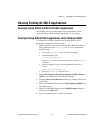
Chapter 4 Debugging Your Application
NI-488.2 User Manual for Windows 4-4 www.natinst.com
Timing Errors
If your application fails, but the same calls issued interactively in the
Interactive Control utility are successful, your program might be issuing
the NI-488.2 calls too quickly for your device to process and respond to
them. This problem can also result in corrupted or incomplete data. This
should only be a problem with older, non-standard GPIB devices.
To check if your interactively issued NI-488.2 calls succeed, use the
Interactive Control utility. To start the Interactive Control utility, complete
the following steps:
1. Select Start»Programs»National Instruments NI-488.2»Explore
GPIB to start Measurement & Automation Explorer.
2. Expand the Devices and Interfaces directory by clicking on the + next
to the folder.
3. Right-click on your GPIB interface and select Interactive Control
from the drop-down menu that appears.
4. At the command prompt, type NI-488.2 API calls to communicate
interactively with the your instrument. For example, you might use
ibdev
,
ibclr
,
ibwrt
,
ibrd
, and
ibonl
.
To view the online help for Interactive Control, type
help
at the Interactive
Control command prompt.
A well-behaved IEEE 488 device does not experience timing errors. If your
device is not well-behaved, you can test for and resolve the timing error by
single-stepping through your program and inserting finite delays between
each NI-488.2 call. One way to do this is to have your device communicate
its status whenever possible. Although this method is not possible with
many devices, it is usually the best option. Your delays are controlled by the
device and your application can adjust itself and work independently on
any platform. Other delay mechanisms probably exhibit differing behaviors
on different platforms and thus might not eliminate timing errors.


















